Section 2 – Application of regulations
2.1 Understand the social environment of road transport and the rules governing it
– maximum working periods specific to the transport industry; application and consequences of European Regulations EC 561/2006, EU 165/2014, and the EU/UK Trade Cooperation Agreement; penalties for failure to use, improper use of and tampering with the tachograph; rights and duties of drivers with regard to the initial Driver CPC qualification and periodic Driver CPC training.
The basis of the law concerning drivers’ hours and the keeping of records can be found in the Transport Act 1968. This has been widely amended since that date and there are several pieces of subordinate UK legislation arising from the Act which still controls the making and keeping of records.
The two major pieces of European legislation affecting most drivers’ hours and tachograph issues are:
- EC 561/2006
- EU 165/2014
These European regulations have been retained in law, and still apply to drivers/vehicles, even though the UK has left the EU. These ‘assimilated laws’ are still commonly called ‘EU rules’, despite the fact that they are no longer exactly the same as the EU regulations.
Journeys in a vehicle operated entirely in the UK will fall under these assimilated laws, unless an exemption applies (see Driver’s hours exemptions and national derogations); if an exemption does apply, the journey will fall under GB or NI domestic rules.
EU/UK Trade Cooperation Agreement
Following Brexit, the EU and UK Trade Cooperation Agreement (TCA) was signed to minimise trade disruption. The TCA includes similar rules on drivers’ hours and tachographs to the EU regulations (at the time of enactment on 1 May 2021). Where there are differences between the TCA and the UK’s assimilated laws, this will be noted in the relevant section.
TCA rules apply to a driver’s journeys to, from, and in the EU if their vehicle is UK registered, unless an exemption applies (see Driver’s hours exemptions and national derogations).
(If the vehicle is registered in the EU, then TCA rules apply to journeys to or from the UK, and EU rules will apply to those journeys solely in the EU, EEA and/or Switzerland.)
AETR (Accord Européen sur les Transports Routiers)
The AETR rules were aligned with the EC 561/2006 in September 2010, therefore the rules governing drivers’ hours are mostly the same as the EU/TCA rules, but there has been a drift between the EU and AETR rules since then. At the time of writing, the AETR rules have not been aligned to the EU 2020/1054 regulations, which amend EC 561/2006 and EU 165/2014. Where there are differences between EU and AETR rules, this will be noted in the relevant section.
As the UK is no longer in the EU, a driver’s journey to, from, in or through any non-EU AETR country falls under AETR rules, unless an exemption applies (see Driver’s hours exemptions); if an exemption does apply, the journey will fall under the domestic rules of each country visited.
(If the vehicle is registered in the EU, EEA or Switzerland, then a driver’s journey solely in the EU, EEA and/or Switzerland falls under EU regulations, whilst a journey to, from or through any other AETR country would fall under AETR rules – except when TCA rules apply.)
Journeys through countries outside the scope of EU, TCA and AETR rules will fall under the domestic rules of each country visited.
Maximum daily driving
A maximum of 9 hours driving each day which may be extended to 10 hours twice in any one fixed week.
Article 6(1) of Regulation EC 561/2006 (and article 4(1) of TCA annexe 31b section 2) states that daily driving time shall not exceed 9 hours. It defines ‘daily driving time’ as the total accumulated driving time which falls between two daily rest periods or between a daily rest period and a weekly rest period. This includes all driving, even where the time spent driving is very short, between these two rest periods. It then goes on to say that this 9 hour driving period may be extended to 10 hours twice in any one week.
Maximum weekly and fortnightly driving
Article 6(2) of Regulation EC 561/2006 (and article 4(2) & 4(3) of TCA annexe 31b section 2) limits the total period of driving in any one week to 56 and for any two consecutive weeks to 90 hours. The 56-hour limit is a natural consequence of maximum daily driving limits. Because the daily driving limit is 9 hours, which can be extended to 10 twice in any week and a driver is limited to no more than 6 daily driving periods in one week, they are therefore restricted to 56 hours (4 × 9 = 36 hours + 2 × 10 = 20 hours, giving a grand total of 56 hours).
However, because there is also a limit of 90 hours in any two consecutive weeks, a driver cannot drive for 56 every week. Any driver driving for the maximum 56 hours in week 1 would only be able to drive for 34 hours in week 2.
Breaks after driving
A driver must have a 45 minute break after a driving period of 4½ hours.
Article 7 of Regulation EC 561/2006 (and article 5 of TCA annexe 31b section 2) states that after a driving period of 4½ hours, a driver must take an uninterrupted break of at least 45 minutes unless they start a daily or weekly rest period. This rest period may be spread over the driving period by splitting it into 2 separate periods the first of which is at least 15 minutes and this must be followed by another break of at least 30 minutes. A driver cannot choose to take the longer break first.
Once a driver has had a break of at least 45 minutes after a 4½ hour driving period or breaks totalling at least 45 minutes spread over that driving period, they may begin another driving period.
Daily rest periods
A driver must have 11 hours rest in every 24-hour period.
‘rest’ any uninterrupted period during which the driver may freely dispose of their time.
Reduced, split or interrupted rest periods
This 11-hour rest can be reduced to 9 hours on three occasions in any week. There is no requirement to pay back the reduced rest i.e. the missing two hours.
It is possible to split a rest period into two periods, the first period must be of at least 3 hours and the second a period of at least 9 hours. This pattern can be worked for 6 consecutive daily driving periods.
Ferry or train crossings
AETR rules. Under AETR derogations from article 8(1), a driver may interrupt a ‘regular daily rest’ period no more than twice to board or disembark from a train or ferry. Where this occurs, the total interruption to the daily rest period shall be no more than 1 hour. During the rest, the driver must have access to a bunk or couchette.
Assimilated, EU and TCA rules. Under EC 561/2006 article 9 (as amended by EU 2020/1054), and TCA annexe 31b section 2 article 6(12), the driver is permitted to interrupt a ‘regular daily rest’ or ‘reduced weekly rest’ period no more than twice to board or disembark from a train or ferry. Where this occurs, the total interruption to the regular daily rest period or reduced weekly rest period shall be no more than 1 hour. During the rest, the driver must have access to a sleeper cabin, bunk or couchette at their disposal.
A ‘regular weekly rest’ may be interrupted in the same manner, provided that the ferry/train journey is scheduled for 8 hours or more, and the driver has access to a sleeper cabin in the ferry or on the train.
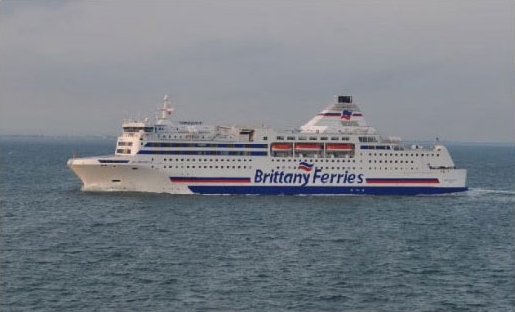
Multi-manning
Under article 4(o) of EC 561/2006, and TCA annexe 31b section 2 article 2(l), ‘multi-manning’ means that during the period between two consecutive daily rest periods there are at least two drivers in the vehicle to do the driving. For the first hour of multi-manning the presence of another driver is optional but for the remainder of the period it is compulsory.
Article 8(5) of EC 561/2006, and TCA annexe 31b section 2 article 6(5), states that where a vehicle is multi-manned then both drivers must have a rest period of at least nine hours in every 30 hours.
AETR rules. Under AETR article 7, a driver may take a 45 minute break in a vehicle when it is being driven by another driver.
Assimilated, EU and TCA rules (not currently AETR). Under EC 561/2006 article 7 (as amended by EU 2020/1054), and TCA annexe 31b section 2 article 5, a driver may take a 45 minute break in a vehicle when it is being driven by another driver, provided they are not assisting the driver (e.g. map reading).
Weekly rest periods
‘weekly rest period’ means the weekly period during which the driver may freely dispose of their time and covers a ‘regular weekly rest period’ and a ‘reduced weekly rest period’:
- ‘regular weekly rest period’ means any period of rest of at least 45 hours,
- ‘reduced weekly rest period’ means any period of rest of less than 45 hours, which may, subject to the conditions laid down in Article 8(6) of EC 561/2006, and TCA annexe 31b section 2 article 6, be shortened to a minimum of 24 consecutive hours. Any reduction in weekly rest must be paid back, en block, by the end of the third week following that of the reduction
A decision taken in the European Court of Justice (ECJ) in 2017 means that a driver can no longer take a regular weekly rest (45 hours) in the cab of their vehicle.
Assimilated, EU and TCA rules (not currently AETR). Under EC 561/2006 article 8 (as amended by EU 2020/1054), and TCA annexe 31b section 2 article 6(9) & 6(10), a regular weekly rest may not be taken in a vehicle and must be taken in suitable, gender-friendly accommodation with adequate sleeping and sanitary facilities (with any costs for accommodation outside of the vehicle covered by the driver’s employer).
In addition, a driver’s work must be organised so that they may return to the operating centre at which they are normally based, or their place or residence, within each period of four consecutive weeks (or by the start of the regular weekly rest period after two consecutive reduced weekly rest periods).
Summary of the drivers’ hours rules under assimilated, EU, TCA and AETR laws/treaties
| DRIVING HOURS | |
| DAILY | 9 hours may be extended to 10 hours twice in a week |
| WEEKLY | Maximum of 56 hours in a week |
| FORTNIGHTLY | 90 hours in two consecutive weeks |
| BREAKS | 45 minutes after 4½ hours of continuous or aggregated driving. Alternatively, this break can be split into two periods; the first at least 15 minutes the second at least 30 minutes. |
| MULTI-MANNING |
A driver may take a 45 minute break in a vehicle when it is being driven by another driver.
Additional conditions under assimilated, EU and TCA rules |
| DAILY REST | In each 24 hours a daily rest must be taken. |
| REGULAR | At least 11 hours. |
| REDUCED | Less than 11 hours but at least 9 hours. May be taken a maximum of three times in a week. |
| SPLIT REST | A regular rest period can be taken in two separate periods; The first period at least 3 hours and the second at least 9 hours. |
| MULTI-MANNING | At least 9 hours within 30 hours of the end of a daily or weekly rest period. |
| FERRY/TRAIN CROSSING |
A regular daily rest can be interrupted not more than twice by other activities not exceeding 1 hour in total.
Conditions under AETR rules
Conditions under assimilated, EU and TCA rules |
| WEEKLY REST | After a maximum of six 24 hour periods a weekly rest must be taken |
| REGULAR |
At least 45 hours, which must not be taken in the vehicle.
Additional rights under assimilated, EU and TCA rules A driver’s work must be organised so that they may return to the operating centre at which they are normally based, or their place or residence, within each period of four consecutive weeks (or by the start of the regular weekly rest period after two consecutive reduced weekly rest periods). |
| REDUCED | At least 24 hours. In any two consecutive weeks there must be two regular rest periods or one regular and one reduced. A weekly rest period that falls in two weeks may be counted in either week but not in both |
| COMPENSATION | A reduced weekly rest period must be compensated en bloc by the end of the third week following the reduction and attached to another rest period of at least 9 hours. |
| FERRY/TRAIN CROSSING |
Additional rights under assimilated, EU and TCA rules A regular weekly rest, can be interrupted not more than twice by other activities not exceeding 1 hour in total, provided the ferry/train journey is scheduled for 8 hours or more and the driver has access to a sleeper cabin in the ferry or on the train. |
Emergencies and exceptional circumstances
Drivers may be exempt from the provisions of the Regulations as they relate to driving or rest periods to enable them to get to a suitable stopping place when emergencies arise. Emergencies are not foreseeable, and a journey should not be planned to exceed any of the limits set out in the Regulation. Known road works or heavy traffic areas will not count as an emergency and cannot be used as an excuse to extend driving time or reduce rest time.
A driver may only extend their driving time by the minimum amount necessary to ensure the safety of persons, the load or the vehicle and only when road safety is not jeopardised. The nature of the emergency should be written on the back of the tachograph or digital printout before, or when, they reach their destination/suitable stopping place.
Assimilated, EU and TCA rules (not currently AETR). Under EC 561/2006 article 12 (as amended by EU 2020/1054), and TCA annexe 31b section 2 article 8(1) & 8(2), provided road safety is not jeopardised, a driver may in exceptional circumstances may exceed daily and weekly driving time by up to one hour in order to reach their employer’s operational centre or their place of residence. Under the same conditions, provided the driver takes an uninterrupted break of 30 minutes beforehand, they may exceed daily and weekly driving time by up to two hours. The reason for the extension should be written on the back of the tachograph or digital printout before, or when, they reach their destination/suitable stopping place.
Any extension period taken must be compensated by an equivalent rest period taken en block with any rest period, by the end of the third week after the extension was taken.
Driver’s hours exemptions under assimilated, EU, TCA and AETR rules
Drivers of certain vehicles (or certain vehicle use cases) may be exempt from drivers’ hours rules and the requirement to use tachographs under assimilated and EU law, and TCA and AETR treaties. Where this is the case, the driver may still be subject to domestic drivers’ hours regulations in the country/countries in which they drive.
Below is a summary of the exemptions that may apply to goods vehicles (as found in EC 561/2006 articles 2 & 3, TCA annexe 31b section 2 articles 1(3) & 1(4) and AETR article 2):
Exemptions common to assimilated, EU, TCA and AETR rules
- Vehicles with a maximum authorised speed not exceeding 40 km/h
- Vehicles owned or hired without a driver by the armed services, civil defence services, fire services, and forces responsible for maintaining public order when the carriage is undertaken as a consequence of the tasks assigned to these services and is under their control
- Vehicles used in emergencies or rescue operations
- Specialised vehicles used for medical purposes
- Specialised breakdown vehicles operating within a 100 km radius of their base
- Vehicles undergoing road tests for technical development, repair or maintenance purposes, and new or rebuilt vehicles which have not yet been put into service
- Vehicles (or combinations of vehicles) with a maximum authorised mass not exceeding 7.5 tonnes used for the non-commercial carriage of goods
- Commercial vehicles, which are used for the non-commercial carriage of goods and which have a historic status according to according to the legislation of the UK or EU/AETR country in which they are being driven
Exemptions common to assimilated, EU and TCA rules (not currently AETR)
- Vehicles used for the carriage of goods with a maximum authorised mass not exceeding 3.5 tonnes (2.5 tonnes from 1st July 2026), including any trailer or semi-trailer
-
Vehicles or combinations of vehicles with a maximum authorised mass not exceeding 7.5 tonnes used for:
- carrying materials, equipment or machinery for the driver’s use in the course of the driver’s work, or
- for delivering goods which are produced on a craft basis
only within a 100 km radius from the base of the undertaking and on the condition that driving the vehicle does not constitute the driver’s main activity and transport is not carried out for hire or reward
- Vehicles with a maximum authorised mass, including any trailer or semi-trailer, exceeding 2.5 tonnes but not exceeding 3.5 tonnes that are used for the transport of goods, where the transport is not effected for hire or reward, but on the own account of the company or the driver, and where driving does not constitute the main activity of the person driving the vehicle
Exemptions common to assimilated, EU and AETR rules
- Vehicles used for the carriage of passengers which are constructed or permanently adapted for carrying not more than nine persons, including the driver, and are intended for that purpose
- Vehicles used for the carriage of passengers on regular services where the route covered by the service in question does not exceed 50 km
- Commercial vehicles, which are used for the non-commercial carriage of passengers and which have a historic status according to according to the legislation of the UK or EU/AETR country in which they are being driven
Exemptions exclusive to AETR
- Vehicles used for the carriage of goods with a maximum authorised mass not exceeding 3.5 tonnes, including any trailer or semi-trailer.
Driver’s hours national derogations under assimilated, EU and TCA rules
In addition to the above exemptions, there are also ‘national derogations’, which are exemptions that apply only within a country’s own territory (unless mutual agreement is reached with another country). Under the TCA and EU regulation EC 561/2006, there is list of standard derogations that countries may enact.
Below is a summary of the derogations that can apply to vehicles in the UK under assimilated law (The Community Drivers’ Hours and Recording Equipment Regulations 2007 articles 2 & 4 and The Community Drivers’ Hours and Recording Equipment (Exemptions and Supplementary Provisions) Regulations (Northern Ireland) 2009 articles 3 & 5), and those that may exist in EU member states (EC 561/2006 article 13 and TCA annexe 31b section 2 article 8(3)):
Derogations common to assimilated, EU and TCA rules
-
Vehicles owned or hired, without a driver, by public authorities to undertake carriage by road which do not compete with private transport undertakings.
In the UK this means vehicles used:
- for the provision of ambulance services
- for the transport of organs, blood, equipment, medical supplies or personnel
- by a local authority to provide social services functions for old people, or physically/mentally handicapped people
- by HM Coastguard or lighthouse authorities
- for the purpose of maintaining railways
- for the purpose of maintaining navigable waterways.
- Vehicles used or hired, without a driver, by agricultural, horticultural, forestry, farming or fishery undertakings for carrying goods as part of their own entrepreneurial activity within a radius of up to 100 km from the base of the undertaking
- Vehicles or combinations of vehicles with a maximum authorised mass not exceeding 7.5 tonnes used by universal service providers to deliver items as part of the universal service. These vehicles shall be used only within a 100 km radius from the base of the undertaking, and on condition that driving the vehicles does not constitute the driver’s main activity
- Vehicles operating exclusively on islands isolated from the rest of the national territory not exceeding 2,300 km² in area which are not linked to the rest of the national territory by a bridge, ford or tunnel open for use by motor vehicles
- Vehicles used for the carriage of goods within a 100 km radius from the base of the undertaking and propelled by means of natural or liquefied gas or electricity, the maximum authorised mass of which, including the mass of a trailer or semi-trailer, does not exceed 7.5 tonnes
-
Vehicles used in connection with:
- sewerage, flood protection, water, gas and electricity maintenance services
- road maintenance and control
- door-to-door household refuse collection and disposal
- telegraph and telephone services
- radio and television broadcasting
- the detection of radio or television transmitters or receivers.
- Specialised vehicles transporting circus and funfair equipment
- Specially fitted mobile project vehicles, the primary purpose of which is use as an educational facility when stationary
- Vehicles used for milk collection from farms and/or for the return to farms of milk containers or milk products intended for animal feed
- Vehicles used for carrying animal waste or carcasses which are not intended for human consumption
- Vehicles used exclusively on roads inside hub facilities such as ports, interports and railway terminals
- Vehicles used for the carriage of live animals from farms to local markets and vice versa or from markets to local slaughterhouses within a radius of up to 100 km.
Derogations common to assimilated and EU rules
- Vehicles used for driving instruction and examination with a view to obtaining a driving licence or a certificate of professional competence, provided that they are not being used for the commercial carriage of goods or passengers
- Vehicles with between 10 and 17 seats used exclusively for the non-commercial carriage of passengers.
Derogations exclusive to assimilated rules
- Vehicles used by the Royal National Lifeboat Institution (RNLI) for the purpose of hauling lifeboats
- Vehicles manufactured before 1st January 1947 (England, Wales and Scotland only)
- Vehicles propelled by steam (England, Wales and Scotland only).
Domestic drivers’ hours legislation
Certain drivers may be exempt from the assimilated (aka ‘EU rules’), TCA and AETR drivers’ hours rules but that does not necessarily mean that they are exempt all forms of record keeping or drivers’ hours rules. They may fall into GB or NI domestic legislation if they drive one of these vehicles for more than 4 hours and outside a 50 km radius of their vehicle’s operating base in any one day. If a driver only drives for more than four hours on one day of any fixed week (00:00 Monday to 24:00 Sunday) then they must keep a record for the whole of that week.
Maximum permitted driving time (domestic)
Under this legislation, drivers must observe a maximum driving time of 10 hours in any 24 hour period.
Driving off-road driving for agricultural, quarrying, forestry or construction purposes counts as duty time rather than driving time.
Duty time (domestic)
Drivers are exempt from the daily duty time limit on working days where no driving takes place, but if driving does take place:
Great Britain. The length of the working day (spreadover) must be no more than 11 hours between the times of starting and finishing work (including work other than driving and off-duty periods during the working day).
Northern Ireland. The length of the working day (spreadover) must be no more than 14 hours between the times of starting and finishing work (including work other than driving and off-duty periods during the working day).
Rests and breaks (domestic)
Great Britain. Rather oddly, The Drivers’ Hours (Goods Vehicles) (Modifications) Order 1986 removes many the rest and break requirements of the Transport Act 1968 for goods vehicle drivers driving under domestic rules in Great Britain. However, the maximum duty time of 11 hours implies a daily rest period of 13 hours (i.e. 24 - 11 = 13), but this rest would not necessarily need to be taken in a single block.
Even though the domestic drivers’ hours code does not prescribe breaks or rest for goods vehicle drivers, The Working Time Regulations 1998 require that mobile workers have ‘adequate rest’, which means regular rest periods that are sufficiently long so that drivers do not cause injury to themself or others through fatigue or irregular working patterns, or damage their short or long term health.
Northern Ireland. Northern Ireland’s domestic driving rules differ from those in Great Britain, and the domestic rules are contained in two laws Vehicles (Drivers’ Hours of Duty) Regulations (Northern Ireland) 1991 and Vehicles (Drivers’ Hours of Duty) (Amendment) Regulations (Northern Ireland) 1992.
Under NI domestic rules, After 5 hours cumulative or continuous driving a break of at least 30 minutes must be taken in which the driver is able to obtain rest and refreshment, if the driver has not taken such a break during or between those periods of driving, unless it is the end of their working day.
A driver must have a daily rest period of at least 10 hours continuous rest between 2 working days.
Emergencies
Where events cause, or are likely to cause:
- Danger to life
- Serious interruption to the maintenance of gas, water, electricity or telecommunications or postal delivery services, or
- Serious interruption to the use of roads, ports or airports
…then the driving and duty limits maybe exceeded provided that the driver does not spend time on duty (other than to deal with the emergency) longer than necessary. This fact must be recorded on the record sheet.
Record keeping (domestic)
Drivers subject to GB or NI domestic record keeping must record their work in an approved form of Record Book, or alternatively with an approved tachograph (where fitted). This record book must contain numbered pages upon which a driver may make daily entries on a weekly sheet with a duplicate copy of that record being made as a result of the original entry. These copies must be returned to the employer within 7 days of completion. The employer should check the entries made in these books within 7 days of receipt. Employers (and owner-drivers) must keep record books for a period of at least 1 year from the date which they were completed or ceased to be used.
Mixed domestic and assimilated/TCA/ATER record keeping
If you drive under a mix of domestic and assimilated (aka ‘EU rules’), TCA or AETR rules, then you must keep records in accordance with the assimilated, TCA or AETR rules in addition to domestic record keeping.
Under assimilated, TCA and ATER rules, drivers must be able to produce records for the current day and the preceding 28 days under assimilated or AETR rules, and 56 days under TCA. These records need to cover driving time, availability and other work, as well as breaks and rest periods (and in the case of assimilated and TCA rules, annual leave and sick leave too) for each and every day. When you are unable to record tachograph entries, because you are away from a vehicle with a tachograph, upon returning to a vehicle with a tachograph, you must make manual entries on your digital tachograph driver card, tachograph printout or tachograph chart. If that is not possible for technical reasons, or is excessively burdensome, then a standard EU/AETR attestation form may be used instead.
When manually recording driving or other duty that took place under GB or NI domestic rules for the purposes of assimilated, TCA or ATER record keeping, this must be recorded as ‘other work’ (under article 6(5) of EC 561/2006) with a manual entry:
- on your driver card with a digital or smart tachograph
- on a printout from a digital or smart tachograph
- on the back of an analogue tachograph chart.
Driver responsibilities (domestic record book)
On receipt of a new record book, a driver must complete the information fields on the front cover, providing the following information:
- Surname
- First name
- Date of birth
- Address
- Date book first used, and
- Name and address of any other employers
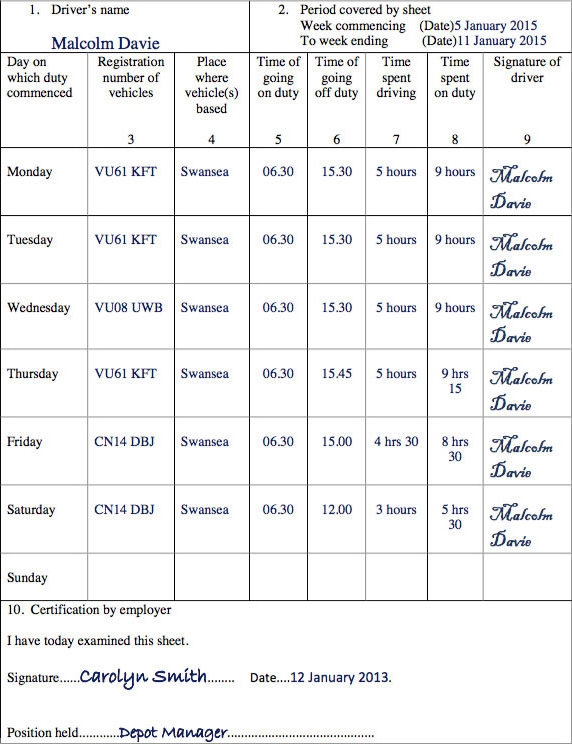
Production of records by driver
Drivers are required to be able to produce records for the current day and for the previous 28 days. These records may take the form of a tachograph record sheet or chart or a digital driver card. N.B. If a driver has been issued with a digital driver card, they should always be able to produce that card to an authorised officer whether or not the driver is driving a vehicle fitted with a digital tachograph.
EU and TCA rules (not currently assimilated rules or AETR). Under EU 165/2014 article 36 (as amended by EU 2020/1054), and TCA annex 31b section 4(10), drivers are required to be able to produce records for the current day and for the previous 56 days to an authorised inspecting officer.
Possible enforcement action
Enforcement of the drivers’ hours regulations is carried out by DVSA or the police in the UK. Both agencies have the power to require the production of tachograph records (either analogue charts or digital printouts, cards and equipment) at the roadside or at any premises. The police, and many DVSA officers, have the power to stop a goods or passenger carrying vehicle on the road.
Drivers and vehicles can be prohibited from further movement if they are found to have breached any drivers’ hours law. It is possible to be prohibited for a full 45 hours if the driver is unable to provide evidence of a weekly rest period.
Drivers may receive ‘on-the-spot’ fines in both the UK and the rest of Europe. In the UK, drivers, and their employers, could be prosecuted in either magistrates or crown court for drivers’ hours offences. The maximum penalty for most drivers’ hours offences is a fine of £2,500. Misuse of the tachograph or any false records, however, can result in a maximum fine of £5,000 or 2 years imprisonment.
The relevant Traffic Commissioner in the UK can take into account any offences committed in another country when considering the good repute of the operator or the driver’s suitability to hold a vocational licence.
Lost or stolen digital driver tachograph card
If a driver loses their digital tachograph card, then they must inform DVLA within 7 days and apply for a replacement card. The driver may continue to drive for a period of 15 days whilst making manual entries. Under these circumstances, where it is necessary to make a manual entry, the driver must take one printout at the start of the day, noting their name, signature and either digital tachograph card or driver number on that printout. At the end of the day the driver must make another printout, again entering those details on that printout, and keep them together for as long as they would an analogue record before returning them to their employer.
Drivers of digital vehicles must always be able to produce a printout from the vehicle unit and must therefore always carry sufficient paper for this purpose.
Theft of a driver card must be formally declared to the competent authorities in the state where the theft occurred.
Working Time Directive requirements
All drivers and crew members subject to the assimilated (aka ‘EU rules’), TCA or AETR drivers’ hours law must also comply with the Road Transport (Working Time) Regulations 2005.
Working time includes:
- driving, loading and unloading
- work to ensure the safety of the vehicle and its cargo (e.g. daily driver checks)
- waiting time that cannot be classed as a ‘period of availability’
- any other work including administrative work, and
- job related training or any other training that is related to the employer’s commercial transport operation (this would include time being used for training under the Driver Certificate of Competence Regulations
Maximum and average weekly working hours
A driver must not exceed an average of 48 hours work each week. There is also an absolute limit of 60 hours work in any week. Only non-mobile workers that may opt out of the 48 hour weekly average limit – this option is not available to those subject to assimilated (aka ‘EU rules’), TCA or AETR rules.
Break requirements
Drivers must take a break of at least 30 minutes after 6 hours of work (this includes both driving and other work) however, the breaks from driving required by the assimilated, TCA, EU or AETR rules must take precedence (i.e. a driver must also meet the requirement to have a 45 minute break after four and a half hours of driving). The 30 minute break for WTD purposes can be split but each break must be of at least 15 minutes duration or it will not be counted as rest. A further 15-minute break must be taken if the driver exceeds 9 hours of working time.
Reference periods
Reference periods are normally calculated over a 17 week period although this may be extended to 26 or up to 52 weeks by collective workforce agreement. Any such workforce agreement must be referred back to the workforce at least every 5 years.
Periods of availability
Generally speaking, a period of availability (PoA) is waiting time whose duration is known about in advance by the mobile worker. A mobile worker should not be required to remain at their workstation;
- (but) they must be available to answer calls to start work or resume driving on request, and
- the period and the foreseeable duration should be known in advance either before departure or just before the start of the period in question
Night work
Night work is considered to be any working time, which includes the period 00:00–04:00 hours (for goods vehicle drivers). Where any work is carried out which includes this period, the maximum working period is 10 hours. This 10-hour limit can only be exceeded under a collective or workforce agreement to opt out of this particular requirement.
Workforce and collective agreements
It is possible to vary certain conditions contained within the WTD, e.g. extend the reference period or vary the 10 hour night work limit. This can only be done via a ‘collective agreement’ or a ‘workforce agreement’. A ‘collective agreement’ is defined as ‘an agreement between the employer and an independent trade union or trades union’. A ‘workforce agreement’ is defined as being ‘an agreement between the employer and the elected representatives of the workforce’. Where there are less than 20 employees, a workforce agreement can be put into place with the agreement of the employer and the majority of the workforce. Any such workforce agreement must be made in writing and is valid for a maximum of five years.
Exemptions from the requirements of the Working Time Directive
There are certain exemptions to the Working Time Directive, but these do not apply to workers subject to assimilated (aka ‘EU rules’), TCA or AETR drivers’ hours rules.
The exemptions apply to:
- Security and surveillance activities requiring a permanent presence in order to protect property or persons
- For reasons of continuity of service and production, workers at docks and airports, press, radio and television productions and postal and communication services
- Where there is a foreseeable surge of activity such as in agriculture, tourism or postal services, and
- Where workers activities are affected by unusual and unforeseeable circumstances beyond the control of the employer e.g. accident or risk of an accident
Record keeping
An employer of a mobile worker must keep records of their staff and, in order to make this a full record, must ask any employee about any other work they may do for any other employer or employers.
Regulation 11 of the WTD requires an employer to keep records for 2 years following the end of the period to which they refer for drivers subject to assimilated/TCA/ATER rules. These records must be made available, on request, to an authorised inspecting officer. In the UK it is the HSE who are charged with enforcement of these Regulations although DVSA act as the ‘eyes and ears’ of HSE by reporting facts found on the road.
Fitment and use of recording equipment
Article 3 of EC 165/2014, and TCA annexe 31c section 2 article 3(1), requires that recording equipment be installed and used in any vehicle (over 3.5 tonnes maximum authorised mass) registered in the UK, or an EU member state, which is used for the carriage of goods. Such equipment has to be installed in accordance with the Regulations by a registered workshop.

The Regulations allow for both analogue and digital equipment although, since May 2006 only digital equipment may be fitted to any new vehicle. Workshop fitters will use a digital workshop card to access the head of that equipment in order to calibrate it and enter certain vehicle details into it (e.g. the registration mark).
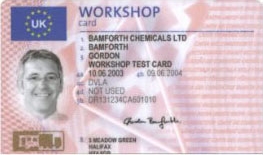
More recently, digital tachographs with enhanced functionality, known as ‘smart tachographs’, have been introduced. The second and most recent version of the smart tachograph includes features such as: Automatic country code entry at borders, suggestion of start/end of daily working period country (based on GPS/Galileo location), and short range radio communication of tachograph data (allowing remote inspection of drivers’ hours by authorities).
EU and TCA rules (not currently assimilated rules or AETR). Under EU 165/2014 article 3(4), as amended by EU 2020/1054, and TCA annex 31c section 2(3), a smart tachograph 2 must be fitted to all vehicles, with a maximum authorised mass (including any trailer or semi-trailer) of over 3.5 tonnes, that are engaged in international transport, and:
- From 1 July 2026 – Vehicles with a maximum authorised mass (including any trailer or semi-trailer) over 2.5 tonnes, that are engaged in international transport
(Fitting and retrofitting of smart tachograph 2 is not required for HGVs that undertake international journeys that fall solely under AETR rules.)
Driver’s responsibilities – analogue chart start of duty
- ensure that the time recorded on the tachograph is set to that in the country of registration of the vehicle
- insert their surname and first name on the tachograph sheet
- the date and place where the duty begins
- the registration number of the vehicle, and
- the start odometer reading
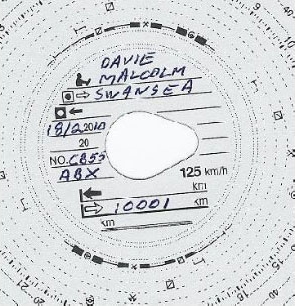
Driver’s responsibilities – analogue chart during the duty
During the course of the working day, the driver must:
-
operate the mode switch so that the instrument correctly records the type of duty performed:
-
 to record driving (most tachographs will change to this mode automatically)
to record driving (most tachographs will change to this mode automatically)
-
 to record periods of other work (e.g. daily checks, loading/unloading, re-fuelling, etc.)
to record periods of other work (e.g. daily checks, loading/unloading, re-fuelling, etc.)
-
 to record periods of availability (e.g. waiting in a queue to load at a port, non-driving time in a coach where you may be called upon to deal with passenger requests, map reading or navigating, etc.). Time worked for other non-road transport employers should also be recorded under this symbol – making a manual entry where it is not possible to use the recording equipment provided
to record periods of availability (e.g. waiting in a queue to load at a port, non-driving time in a coach where you may be called upon to deal with passenger requests, map reading or navigating, etc.). Time worked for other non-road transport employers should also be recorded under this symbol – making a manual entry where it is not possible to use the recording equipment provided
-
 to record all breaks and daily rest periods
to record all breaks and daily rest periods
-
 Assimilated, EU and TCA rules (not currently AETR). Under EU 165/2014 article 34(5), as amended by EU 2020/1054, and TCA annex 31b section 4(6), to record all breaks and daily rest periods and annual leave or sick leave
Assimilated, EU and TCA rules (not currently AETR). Under EU 165/2014 article 34(5), as amended by EU 2020/1054, and TCA annex 31b section 4(6), to record all breaks and daily rest periods and annual leave or sick leave
-
- Assimilated, EU and TCA rules (not currently AETR). Under EU 165/2014 article 34(7), as amended by EU 2020/1054, and TCA annex 31b section 4(6), enter the country symbol after crossing the border of an EU member state (or the UK) at the beginning of their first stop, which must be at ferry port/train station of arrival or the nearest stopping place at or after the border for road borders.
Driver’s responsibilities – analogue chart change of vehicle
- where a driver changes vehicle during the course of the working day they must:
- complete the front of the chart as if finishing a duty (except for finish date & place which should remain blank until end of duty)
- record the registration number of any other vehicles they drive
- record the time of any such change
- record the start odometer reading at the time of the change, and
-
record the end odometer reading.
(all of the above should be recorded in the place set out for this information on the rear of the chart)
Driver’s responsibilities – analogue chart – tachograph malfunction
- where the tachograph malfunctions during the course of a duty, a driver must:
- make manual records of that duty, and
- record the malfunction on the defect sheet/record book provided
- where, because they’re away from the vehicle, a driver is unable to use the equipment provided to record their work, then they must record any periods of work, rest and availability on the record sheet
-
produce the record for that day and the preceding 28 days to an authorised inspecting officer
EU and TCA rules (not currently assimilated rules or AETR). Under EU 165/2014 article 36 (as amended by EU 2020/1054), and TCA annex 31b section 4(10), drivers are required to be able to produce records for the current day and for the previous 56 days to an authorised inspecting officer.
- where the driver has driven a vehicle fitted with a digital tachograph during any of the above period, then they must be able to produce the printout from that digital equipment
- Where a chart is taken or seized by an authorised inspecting officer then the driver must make out a new chart and ask the inspecting officer to sign it to the effect that they have taken the original chart. The driver must then record the remaining duties for that day on that chart

Driver’s responsibilities – analogue chart end of duty
At the end of the working day, the driver must:
- enter the date and place where the duty finishes
- enter the end odometer reading
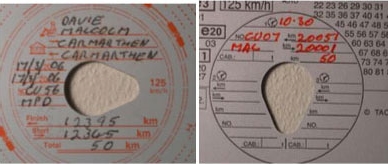
A driver must use the mode switches to accurately record the nature of the duties performed during the day. It is important to remember that the so called ‘automatic tachograph’ only ‘automatically’ records driving time. Only the driver can distinguish between rest, other work or periods of availability.
Drivers must enter the start and finish places in full – abbreviations are not acceptable. (Digital tachographs only require the national ID e.g. ‘I’ for Italy or ‘NL’ for the Netherlands to be recorded except in Spain where regional identities are used).
Drivers must enter the date at the start and at the end of the duty even when these dates may be the same. Odometer readings must be recorded in full (although it is not necessary to record tenths).
All of the above is equally appropriate for entries on the reverse of the chart (e.g. when the driver is using more than one vehicle, or the vehicle is double manned, and it is necessary to record information on the reverse of the chart).
Digital tachographs
The digital tachograph offers several advantages to the law-abiding driver in that many of the ‘centre field’ details, which a driver has to manually write in on a tachograph chart, are now completed automatically by the instrument itself. A digital tachograph will take details of the drivers name directly from their driver card as soon as it is inserted into the instrument. It will also take the correct time and odometer readings from its own internal memory at the point that the card is inserted or taken out.
A driver using a digital tachograph will still have to insert the start and finish place at the start and end of their journey but this will be restricted to the country of start/finish place e.g. ‘UK’ for the United Kingdom or ‘F’ for France and will be selected through a scroll down list programmed into the digital tachograph (smart tachograph 2 units will automatically suggest the country based on the GPS/Galileo location). The one exception to this is Spain where a driver is required to insert a regional code rather than the national ID.
Assimilated, EU and TCA rules (not currently AETR). Under EU 165/2014 article 34(7), as amended by EU 2020/1054, and TCA annex 31b section 4(6), enter the country symbol after crossing the border of an EU member state (or the UK) at the beginning of their first stop, which must be at ferry port/train station of arrival or the nearest stopping place at or after the border for road borders. (Vehicles fitted with smart tachograph 2 will record border crossings automatically.)

Coordinated Universal Time (UTC)
All digital tachographs should be set to Coordinated Universal Time (UTC). UTC is the same as Greenwich Mean Time (GMT), but it is not changed to take account of British Summer Time (BST) hence the internal tachograph clock will not be changed. It is possible however, that the driver may change the clock on the face of the digital tachograph instrument, but this will not affect the internal setting which will always record according to UTC. It is UTC, which will be used on any digital printout or record so any driver will have to take this into account when working away from the vehicle.
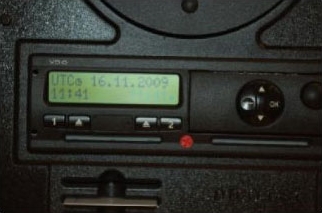
The driver will still need to change the mode switch to take account of the particular activity at the time. It is important to note that most digital tachographs fitted to vehicles after September 2007 will automatically return to the ‘rest’ mode (bed symbol) after any period of driving regardless of whatever was set prior to the start of driving. In the case of digital tachographs fitted to vehicles between May 2006 and September 2007 the mode will return to ‘other work’ (crossed hammers symbol) after any period of driving.
Production of records
When required to do so by an authorised officer (normally a DVSA examiner or a police officer or their foreign equivalent) a driver must:
- be able to produce their digital tachograph driver card
- be able to produce the tachograph record for any analogue vehicle in the relevant period
- be able to produce a digital printout for any period where they were not able to use their card in the equipment, and
- allow the inspecting officer to download information from the driver card or the vehicle unit
Downloading driver digital card and vehicle units
Driver cards (or vehicle units) only need to be downloaded in respect of ‘…days with a recorded activity…’ i.e. if the card has not been used, it does not need to be downloaded. A vehicle unit must be downloaded at least every 90 days. Driver cards must be downloaded at least every 28 days.
Calibration and inspection requirements (analogue and digital tachographs)
All tachographs, digital and analogue, must be calibrated on installation. A plaque recording the calibration must be fixed on or near the tachograph. Analogue tachographs must be calibrated every six years. Every two years from the date of the calibration, an analogue tachograph must be inspected and checked by an approved tachograph installation workshop. Again, a sticker to this effect will be placed in or near the tachograph head. Any repairs which involve the breaking of seals in the drive-line (gearbox removed, new speedometer cable fitted or new tachograph head fitted) will require the vehicle to be inspected and checked by an approved calibration workshop.
Digital equipment is calibrated every 2 years.
Action to be taken in the event of equipment malfunction
Under EU 165/2014 article 37(1) and TCA annex 31c section 2(16), where the tachograph malfunctions and/or becomes unusable during the course of a journey, the instrument must be repaired by an authorised workshop as soon as possible but in any case, within seven days. During this time, the driver must make manual entries to record all periods of driving, rest, availability and other work. These can be made on the back of a tachograph chart using the grid provided for this purpose. The registration number of the vehicle, start/finish times and places must also be recorded. The reason for the manual entry should be recorded on the chart.
In the case of a digital tachograph, where the machine or card malfunctions or the driver has lost the card, the driver must take a printout at the start of their duty and write their name and either driver licence number of digital tachograph card number on the reverse of the printout and sign it.
The driver should then use the mode switches in the normal manner to indicate all periods of drive, other work, rest and PoA.
At the end of the duty the driver should take a second printout and complete the details as above on the reverse of the printout.
Both printouts should then be stapled together and kept for the same period of time as a tachograph record (28 days) before being handed in to the employer.
EU and TCA rules (not currently assimilated rules or AETR). Under EU 165/2014 article 36 (as amended by EU 2020/1054), and TCA annex 31b section 4(10), drivers are required to be able to produce records for the current day and for the previous 56 days to an authorised inspecting officer.
Driver licensing
In the UK, DVLA has responsibility for the issue of all licences in England, Scotland and Wales and the Driver & Vehicle Licensing Agency for Northern Ireland (DVLNI) has responsibility for issuing licences in Northern Ireland.
Applications for ‘ordinary’ driving licences i.e. category B, are made using form D1. Those for vehicles over 3,500 kg are made on a form D2 accompanied by Form D4 – the medical report.
Requirements for applicants for a Category C licence
Applicants for a category C licence must satisfy the following:
- They must not be suspended or disqualified from obtaining a vocational licence
- Hold a full (not provisional) category B licence
- Be aged 18 or over (17 or over for British armed forces personnel)
- Meet the necessary medical standards (including eyesight), and
- Be a fit person as regards previous and current conduct to hold a vocational licence
The newer, plastic photocard licences are valid for 10 years and must be renewed each 10 years thereafter until the age of 70 when the renewal period drops to every three years. A vocational licence needs to be renewed every five years. It is the responsibility of the driver and for the employer to check the validity of the licence. The driver is responsible for the renewal of the licence.
Medical requirements
For category C licences, a medical report is required on first application and on each renewal after the age of 45. Once a vocational licence holder reaches the age of 65, they must renew that licence annually.
For drivers having passed their vocational licence test after 19 January 2013, they must also complete a medical declaration every 5 years up to the age of 45.
A driver must notify DVLA of any medical condition which might affect their driving.
Enforcement and disciplinary procedures
A driving licence must be produced ‘on demand’ to a police officer. In practice, if the licence is not available, there being no mandatory carriage of the licence in the UK, a driver would be given 7 days to produce their licence at a police station of their choice. DVSA examiners have a similar power to demand production of a vocational driving licence within 10 days to ‘an office of the Secretary of State for Transport’.
A driving licence can be endorsed with penalty points, suspended (i.e. where the driver is banned for a period of time) or revoked and the driver required to take another test by a court.
The Traffic Commissioner also has the power to suspend or revoke a vocational licence on grounds of misconduct.
DVLA can revoke any licence on medical grounds.
Categories of driving entitlement
Category B

Motor vehicles with a Maximum Authorised Mass (MAM) not exceeding 3,500 kg and no more than 8 passenger seats with a trailer not exceeding 750 kg.
Minimum age 17. In the UK, if the driver has passed their test before 1 January 1997, then they will be able to drive a vehicle up to 7,500 kg MAM. (After that date the driver will be restricted to a vehicle up to 3,500 kg MAM).
Category B+E
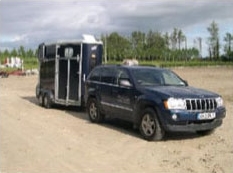
Combination of vehicles consisting of a vehicle in Category B and a trailer in excess of 750 kg.
Minimum age 17.
Category C1

Motor vehicle used for the carriage of goods with a MAM exceeding 3,500 kg but not exceeding 7,500 kg and including such a vehicle drawing a trailer not exceeding 750 kg.
Category C1+E
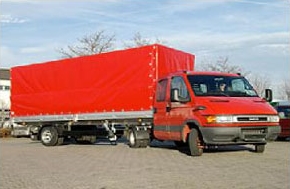
Combination of vehicles where the towing vehicle is in Category C1 and a trailer has a MAM in excess of 750 kg provided that the MAM of the combination does not exceed 12,000 kg and the MAM of the trailer does not exceed the unladen mass of the towing vehicle.
Minimum age 21 (or 18 if the combination does not exceed 7,500 kg).
Category C
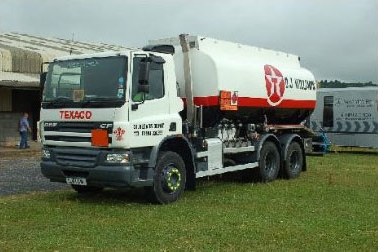
Motor vehicle used for the carriage of goods with a MAM exceeding 3,500 kg, including such a vehicle drawing a trailer not exceeding 750 kg. It does not matter how many axles this vehicle has.
Minimum age 21 (or 17 if a member of the armed services or 18 if National/International Driver CPC qualified).
Category C+E

Large goods vehicle exceeding 3,500 kg MAM towing a trailer with a MAM exceeding 750 kg. This could be a rigid goods vehicle towing a trailer (road train) or a tractive unit towing a semi-trailer (articulated vehicle).
Theory and practical tests
A candidate must pass the appropriate theory test before they can take a practical test in any category. The theory test is computer-based and multiple-choice. This is followed immediately by a hazard perception test.
A candidate for a practical test must present theirself for test with an appropriate vehicle for the category of test to be taken. This vehicle must be loaded to the required weight (see below), fitted with a passenger seat and mirror for the examiner, be fitted with ‘L’ plates, taxed and insured and with enough fuel for the test.
As from November 2013 a vehicle used for certain categories of driving test must be laden.
All drivers must hold a full licence at a lower category before taking a test on a larger vehicle, i.e. a driver must have a full category B licence before taking a category C or C+E test.
Any person supervising a learner driver must have held a full (i.e. not provisional) licence for that category of vehicle for at least three years.
Driver Certificate of Professional Competence
European Directive 2003/59/EC (the Training Directive) requires drivers of certain vehicles to pass the Driver CPC qualification and carry their Driver CPC qualification card with them at all times when driving an LGV or PCV. The Vehicle Drivers (Certificate of Professional Competence) Regulations 2007 brought the European Directive into force in the UK as from September 2009.
The Driver CPC qualification is made up of 4 modules. If a driver wishes to drive a vehicle for hire and reward or in the course of a business, then they will need to pass all 4 modules:
- Module 1: Theory – the multiple-choice theory test and the hazard perception test
- Module 2: Case studies – the multiple-choice case study test
- Module 3: Practical – the off-road exercises test and the on-road driving test
- Module 4: Practical demonstration – the practical demonstration test, which covers topics such as safe loading/unloading, preventing trafficking, handling emergencies, vehicle safety checks, etc.
After passing the initial Driver CPC qualification, the driver will be sent their Driver Qualification Card (this will be an International Driver Qualification Card).
If a driver only drives vehicles that are exempt under the Training Directive (see below), then they only need to pass Modules 1 (Theory) and 3 (Practical).
Acquired rights. LGV drivers who hold a category C, C1, C+E or C1+E driving licence entitlement acquired on or before 10 September 2009 and PCV drivers who hold a D, D1, D+E or D1+E driving licence entitlement acquired on or before 10 September 2009 do not need to pass the initial Driver CPC qualification (due to their experience), and only need to take 35 hours of National or International Driver CPC training in order to obtain the Driver CPC entitlement and their National or International Driver Qualification Card (DQC).
Exemptions from the Training Directive
All drivers of goods carrying vehicles (C1, C1+E, C and C+E) and passenger carrying vehicles (D1, D1+E, D and D+E) with the exception of those listed below fall under the regulations:
-
Vehicles limited to a top speed of 28 mph (45 km/h)
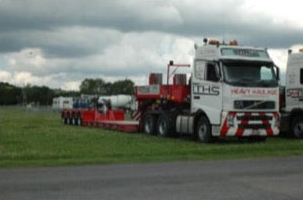 Certain STGO vehicle drivers may be exempt (at least at times) if the vehicle is limited to a top speed of 28 mph (45 km/h)
Certain STGO vehicle drivers may be exempt (at least at times) if the vehicle is limited to a top speed of 28 mph (45 km/h) -
Vehicles used or controlled by the armed forces, civil defence, emergency services or prison service and vehicles used or controlled by a local authority when maintaining public order
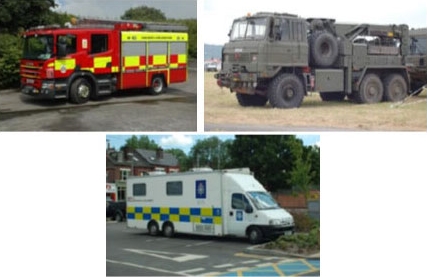 Armed forces, civil defence, the fire service and forces responsible for maintaining public order
Armed forces, civil defence, the fire service and forces responsible for maintaining public order -
Vehicles undergoing road tests for technical development, repair or maintenance purposes, or new or rebuilt vehicles which have not yet been taxed
 New vehicles being delivered on trade plates and drivers of vehicles being used for development would be exempt from driver CPC requirements
New vehicles being delivered on trade plates and drivers of vehicles being used for development would be exempt from driver CPC requirements - Vehicles being driven to a pre-arranged test at an official testing centre
- Vehicles used in states of emergency or assigned to rescue missions
-
Vehicles used in the course of driving lessons for any person wishing to obtain a driving licence or a CPC, as provided for in Article 6 and Article 8(1)
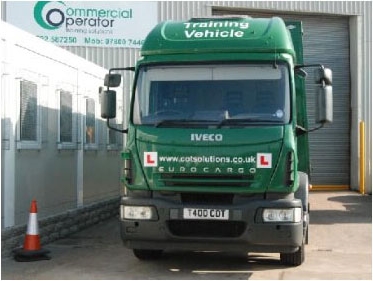 Vehicles used in the course of driving lessons
Vehicles used in the course of driving lessons -
Vehicles used for non-commercial carriage of passengers or goods, for personal use
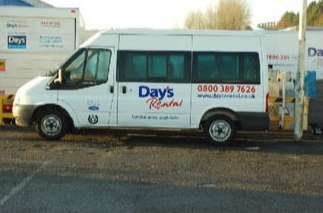 Vehicles used for non-commercial carriage
Vehicles used for non-commercial carriage -
Vehicles carrying material or equipment to be used by the driver in the course of their work, provided that driving the vehicle makes up less than 30% of their rolling monthly work
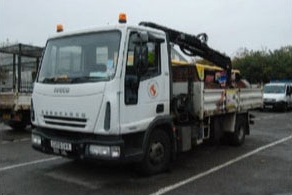 The driver of this vehicle may also be exempt CPC provided they were using it only to carry materials in the course of their work and driving it was not the main activity (parks and gardens work or street repairs for example)
The driver of this vehicle may also be exempt CPC provided they were using it only to carry materials in the course of their work and driving it was not the main activity (parks and gardens work or street repairs for example) - Vehicles being driven within 62 miles (100 kilometres) of their base, when not carrying passengers or goods and when the driver’s main job isn’t driving a lorry, bus or coach
Periodic Driver Certificate of Professional Competence training
Professional drivers need to complete 35 hours of Driver CPC training in every 5 year period to retain their Driver CPC. Since 3 December 2024, drivers can opt for National Driver CPC (if they only drive in the UK) or International Driver CPC (if they want to drive in the UK and the EU or any other AETR country):
- International Driver CPC training. This training option is the same as the old periodic Driver CPC training. You must take 35 hours of international Driver CPC training within each 5 year period. Each training course must last at least 7 hours, and if the course is split, then you must complete it on two consecutive days. Up to 12 hours of the training can be taken in the form of e-learning.
- National Driver CPC training. You must take 35 hours of national Driver CPC training (or a mix of national and international) within each 5 year period. Each training course must last at least 3½ hours. There is no restriction on split courses. Courses can be 100% e-learning based and up to 12 hours of the training can be taken in the form of e-learning.
Regardless of which option you choose, the training centre and course must be Driver and Vehicle Standards Agency (DVSA) and the Joint Approvals Unit for Periodic Training (JAUPT) in order to count.
If you take any National Driver CPC training during a periodic training cycle, but change your mind and want to qualify for an International Driver CPC instead, then you will need to ‘opt-out’ those National Driver CPC training courses on the GOV.UK website, otherwise you will be sent a National Driver CPC Qualification Card – even if you have completed 35 hours or more of International Driver CPC training.
Drivers that have both LGV and PCV licences. Drivers that hold both an LGV and a PCV licence need only complete a total of 35 hours Driver CPC training every 5 years, not 35 hours per licence. You can have both types of Driver CPC card (e.g. national for PCV and international for LGV or vice-versa) if you choose a different Driver CPC training type for each.
Requirement to prove entitlement
Once gained, a driver must always carry evidence of their Driver CPC entitlement when driving a vehicle which is in scope of the regulations. In the UK, this evidence is in the form of a National or International Driver Qualification Card (DQC). The national version of this card has ‘DOMESTIC UK USE ONLY’ printed on the front of it and it is only valid for journeys in the UK. Most EU member states do not have a separate qualification card, instead a code ‘95’ appears in the codes section on the reverse of their driving licence cards.

2.2 Understand the regulations governing the carriage of goods
Operating licences, obligations under standard contracts for the carriage of goods, use of documents used in the delivery and collection of goods including any special documents accompanying goods (e.g. ADR and animals), international transport permits, obligations under the Convention on the Contract for the International Carriage of Goods by Road, the international consignment note, crossing borders, freight forwarders,
Operator licensing
In general terms, goods vehicles exceeding 3.5 tonnes are subject to Operator Licensing if they are used to carry goods in connection with a trade or business or for hire and reward.
From 21 May 2022, an operating licence will also be needed for vans (and cars and vans towing a trailer) that exceed 2.5 tonnes, which are used to carry goods for hire and reward or in connection with a trade or business in the EU, Iceland, Liechtenstein, Norway and Switzerland.
There are three types of operator licence:
- Restricted – the operator can only carry their own goods (both in the UK and abroad)
- Standard National – the operator can carry their own goods or other persons goods for hire and reward in the UK only
- Standard International - the operator can carry their own goods or other persons goods for hire and reward in the UK and abroad
There are seven Traffic Areas in GB. An operator licence is required for each Traffic Area in which the operator will have an ‘operating centre’ and an Operator Licence Identity Disc is issued by the relevant Traffic Commissioner and this should be displayed in the windscreen of the vehicle. A Restricted licence disc is orange in colour, a ‘Standard National’ disc is blue, and a ‘Standard International’ disc is green.
Permits
A system of ‘permits’ is used to control the transport of goods and vehicles between many countries and these permits are issued to UK operators from the International Road Freight Office (IRFO) - Hillcrest House 386 Harehills Lane Leeds LS9 6NF.
TIR convention
The Transports Internationale Routiers (TIR) agreement was made in Geneva in 1975. It covers journeys starting or ending outside of the EU. Its purpose is to simplify and standardise customs procedures between countries and a system of ‘T’ forms is used.
TIR plates
When a road vehicle is carrying out a TIR operation, a rectangular plate bearing the inscription ‘TIR’ and conforming to the TIR Convention specifications must be affixed and be clearly visible at the front and rear of the vehicle. The TIR plate confirms that the vehicle/container meets the required standard and can be sealed for customs purposes.
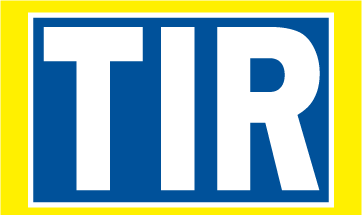
Cabotage and cross-trade services
Cabotage is the carriage of goods between 2 points within a country (loading at one and unloading at the other) by a carrier not registered in that country.
Cross-trade is the carriage of goods between 2 points in two different countries (loading in one country and unloading in another) by a carrier not registered in either country.
To carry out cabotage or cross-trade jobs in the EU, you must have a UK licence for the Community. The UK licence for the Community permits you to carry out up to two haulage jobs, after dropping off goods from the UK. Only one of these may be cabotage, which must take place within 7 days and within the same country where the UK goods were dropped off.
Acquiring a European Conference of Ministers of Transport (ECMT) permit will increase the allowance to three haulage jobs (1 cabotage and 2 cross trade jobs, or 3 cross-trade jobs).
Evidence required whilst engaging in cabotage or cross-trade in the EU
Article 8(3) of EU 1072/2009 requires that the driver, as agent of the operator, must be able to produce proof of the following:
- UK licence for the Community
- European Conference of Ministers of Transport (ECMT), if applicable
- the name, address and signature of the sender of the goods
- the name, address and signature of the haulier
- the name and address of the consignee as well as their signature and the date of delivery once the goods have been received
- the place and date of taking over the goods and the place designated for delivery
- a description of the goods and the method of packing and, in the case of dangerous goods, their generally recognised description as well as the number of packages and their special marks
- the gross mass of the goods, and
- the registration marks of the vehicle and trailer
Since 2 February 2022, under EU Directive EU 2020/1057, you must pre-register a cabotage/cross-trade journey’s details on the EU web portal if you will be moving goods for commercial purposes (including for your own business’s use) between any two points in the EU (including Ireland), Iceland, Liechtenstein or Norway.
Dangerous goods
The main legislation concerning the carriage of hazardous goods in the UK is The Carriage of Dangerous Goods and Use of Transportable Pressure Equipment Regulations 2004.
Where dangerous goods, within the scope of the regulations, are being carried on a goods vehicle, the markings carried on the vehicle or container will be dependent upon the type of goods carried, type of vehicle and type of journey.
Vehicles carrying packaged goods within the scope of the regulations must display an orange board to the front and an orange board to the rear.
Vehicle marking and equipment requirements (ADR)
The operator is responsible for ensuring that the correct information is displayed on the vehicle or container.
The markings found in the picture below are the UN hazard markings and would be appropriate for a vehicle on an international journey.
All vehicles carrying dangerous goods must display a rectangular orange plate to the front. This plate should measure 400 mm × 300 mm and have a black border. Where packaged goods are being carried then the vehicle must display such a plate to the front and the rear.
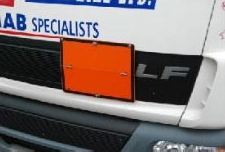
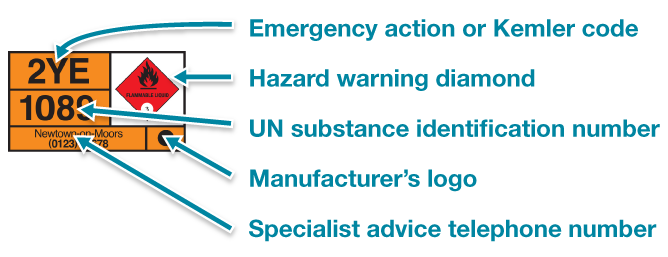
Requirement to carry fire extinguisher
Vehicles carrying dangerous goods generally have to carry two fire extinguishers. For vehicles under 3,500 kg the cab extinguisher must be of at least 2 kg with the total being at least 4 kg. For vehicles exceeding 3.500 but not exceeding 7,500 kg the cab extinguisher must be of at least 2 kg and that in the load area a minimum of 6 kg with a total of at least 8 kg. All vehicles over 7.5 tonnes used for the carriage of dangerous goods must carry at least two fire extinguishers – one for the cab and one for the load compartment. For vehicles over 7.5 tonnes these two extinguishers must, in total, have a capacity of at least 12 kg dry powder (or equivalent) - the cab extinguisher must be of at least 2 kg capacity and the load extinguisher must be of at least 6 kg capacity.
No smoking is permitted inside, or in the vicinity of, any vehicle or container being used for the carriage of dangerous goods. This prohibition includes the use of e-cigarettes.
Requirement to carry chocks
Under ADR, the transport unit has to carry at least one suitable chock for each vehicle (which means at least two chocks for articulated lorries and drawbar combinations). However, GB registered ‘transport units’ on domestic journeys are only required to carry one suitable wheel chock, even if there are two vehicles forming the unit. There is no prescription as to where wheel chocks are to be carried.
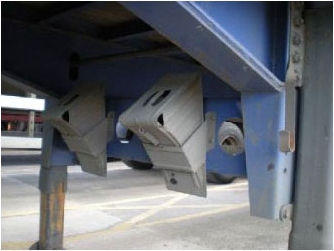
Requirement to carry other equipment
Other requirements include:
- Two self-standing warning signs
- A suitable warning vest or warning clothing for each member of the crew
- A pocket lamp for each member of the crew. The ‘pocket lamp’ has to be suitable for use in a flammable atmosphere in certain circumstances
- Respiratory protective equipment (RPE) where special provision re toxic gasses applies
- PPE and other equipment necessary to take the ‘additional and/or special actions’ referred to in the ‘instructions in writing’
Documentation
Under the ADR regulations, a driver must carry a consignment note (transport document) containing the following information:
- the UN number of the materials being carried
- the correct shipping name and, where appropriate, the technical name
- the class number given in the ADR Dangerous Goods List
- the packing group for the substance concerned
- the number of packages and a description of the packages
- the total quantity of each item
- the name and address of the consignor
- the name and address of the consignee, and
- a declaration as required by the terms of any special agreement
Training requirements for drivers and others involved in the transport of dangerous goods
Drivers of all vehicles carrying hazardous goods must be trained and be in possession of the appropriate ADR Vocational Driver Training Certificate. The ADR certificate lasts for 5 years. Drivers must undertake refresher training, and take a refresher exam at least 6 weeks before their ADR card expires to retain their ADR qualification.
Following industry calls for ADR training to be counted towards the 35 hour periodic Driver CPC training requirement, the DVSA has decided that up to a maximum of 14 hours of the initial ADR course or ADR refresher training can be approved as Driver CPC periodic training within each 5 year training cycle. See GOV.UK for more information.
Sample ADR training certificate

From 1 January 2013 the paper training certificate will be replaced by a plastic card. These cards are now produced and issued by SQA.
.jpg)
Carriage of waste
The Controlled Waste Regulations 1992 sets out the requirements for the registration of waste carriers:
- A carrier must hold a waste carrier’s licence
- Ensure that all consignments of waste are accompanied by the appropriate transfer note or consignment note
- Ensure adequacy of containment of wastes in their control
- Ensure waste does not escape
- Repack waste if necessary
- Make a visual inspection to check accuracy of waste description
- Ensure waste is taken to an appropriate site with a waste management licence or appropriate exemption - make reasonable checks on the waste manager
- Complete and sign transfer notes on any waste transfers to or from another party, and
- Report offences to the Environment agency
A driver must carry a Waste Transfer Note (WTN) or, in the case of hazardous waste, obtain signed consignment notes when they carry hazardous/special materials for recycling or disposal. Failure to produce a WTN may result in the Environment Agency issuing a £300 fixed penalty to the operator concerned.
Carriage of animals
A variety of legislation controls the transport of live animals with pigs, cattle and horses being covered by quite separate regulations. The law is aimed at the prevention of disease and also endeavours to ensure that animals do not undergo unnecessary stress or discomfort while being transported.
Animals must be provided with appropriate food and water before the journey starts and at appropriate points throughout the journey.
Water and food and the opportunity to rest must be made available to animals as appropriate.
Vehicle cleansing and disinfecting
Vehicles must generally be cleaned and disinfected after animals have been carried and before the next consignment is loaded. This cleaning must take place within 24 hours of their unloading.
The interior of the vehicle or container in which the animals were carried must be cleaned as must the wheels, wheel-arches and mudguards of the vehicle.
Animals should be loaded only into transport or receptacles which have been thoroughly cleaned and where appropriate, disinfected.
Dead animals, soiled litter and droppings shall be removed from means of transport or receptacles as soon as possible.
An Animal Transport Certificate is required for journeys of any distance unless it is an international journey of more than 8 hours where a journey log is required. Farmers transporting their own animals on journeys of up to 50 km are exempt from this requirement.
Training
European Regulations (EC 1/2005) came into force in January 2008 and require drivers and attendants engaged in the commercial transport of cattle, pigs, poultry, sheep, goats and horses on journeys of over 65 km to hold an appropriate certificate of competence from an approved body.
Certificate of Competence
From 5 January 2008 transporters of livestock on a journey of over 65 km (40 miles – total length of journey and not as the crow flies) will need to hold a Certificate of Competence issued by an approved body. The Certificate is valid for life.
The Carriage of Foodstuffs
Vehicles, conveyances and any receptacles used for the carriage of food must be kept clean and in good repair. Any other goods or materials which may contaminate any foodstuffs must not be carried in the same containers. Containers or tankers used for carrying foodstuffs in bulk, granular, powder or liquid form must be marked ‘For foodstuffs only’.
Drivers and others engaged in the transport of meat must observe strict standards of cleanliness and hygiene and should wear washable overalls.
Most foodstuffs can be carried at ‘ambient’ temperatures which means that they do not need to be kept at any specific temperature range. However, some foods (frozen fish, salad foods, etc.) must be kept at certain temperatures and these will be carried in refrigerated vehicles. The temperature in these vehicles can be set by the driver and care needs to be taken to ensure that the load area is maintained at the correct temperature for the goods. The fridge on this type of vehicle is normally operated by its own, self-contained motor running from a separate fuel tank. Up until April 2022, these fridge motors could use rebated or ‘red diesel’, but this tax exemption has been removed and it is illegal to red diesel to power them.
The ATP regulations
The ATP regulations set out certain temperature and other requirements for certain goods on international journeys.
An ATP certificate is required for the international transport of perishable products between ATP signatory countries. The regulations do not apply to the transport of perishable goods within the boundaries of any state, they only come into play when a border is crossed. The regulations do cover both own account and hire and reward operations.
CMR
Le Contrat de Transports International de Marchandisses par Route or the Contract for the International Carriage of Goods by Road (CMR) is an international agreement originally signed by Great Britain in 1967. It regulates the contractual duties and liabilities between parties in a hire and reward agreement for the international transport of goods. It sets out various details which concern the haulier, consignor of any goods and any freight forwarder involved in their transport. The model referred to above comprises four differently coloured copies:
- red – the senders copy
- blue – the consignees copy which should accompany the goods
- green – the carriers copy, and
- black – carriers file copy
The consignment note should contain the following details:
- the date of the consignment note and the place at which it was made out
- the name and address of the sender
- the name and address of the carrier
- the place and date of taking over the goods and the place designated for delivery
- the name and address of the consignee
- a description of the goods
- the number of packages
- the gross weight of the goods
- charges relating to the carriage of the goods
- instructions for Customs
- a statement that the carriage is subject, notwithstanding any clause to the contrary, to the provisions of the Convention
CMR does not apply in general to the following:
- Postal articles
- Funeral consignments
- Furniture removals, or
- Carriage of own goods